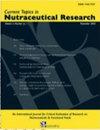一项比较不同铁制剂疗效的随机对照试验研究:酶切体焦磷酸铁、微胶囊焦磷酸铁和静脉注射葡萄糖酸铁
IF 0.4
4区 医学
Q4 NUTRITION & DIETETICS
Current Topics in Nutraceutical Research
Pub Date : 2022-06-23
DOI:10.37290/ctnr2641-452x.20:685-690
引用次数: 0
摘要
尽管有胃肠道副作用,口服铁补充剂是缺铁性贫血的一线治疗方法。本研究的目的是比较不同的铁制剂在门诊贫血患者。106例铁缺乏性小细胞低色素贫血(女性Hb < 12 g/dL,男性Hb < 13 g/dL)的门诊患者被纳入研究,并分为两组(Hb < 10 g/dL和Hb < 10 g/dL)。一组随机(1:1)接受糖质体焦磷酸铁或微胶囊化焦磷酸铁,另一组随机(1:1:1)接受糖质体焦磷酸铁、微胶囊化焦磷酸铁或葡萄糖酸铁静脉注射。随访3个月后,微胶囊化焦磷酸铁组血红蛋白显著高于酶体焦磷酸铁组(1.87 vs 1.10;P = 0.04)。两组间不良事件发生率无显著差异。在血红蛋白血红蛋白为10 g/dL的患者中,焦磷酸或微胶囊焦磷酸铁(30 mg/天)与叶酸(400 mcg)、乳铁蛋白(10 mg)和维生素C (180 mg)联合治疗可显著增加血红蛋白,且无明显副作用。这种有效性的原因可能是由于其良好的生物利用度。需要与其他形式的铁进行进一步的比较研究。本文章由计算机程序翻译,如有差异,请以英文原文为准。
A Randomized Controlled Pilot Study to Compare the Efficacy of Different Iron Formulations: Sucrosomal Ferric Pyrophosphate, Micronized Microencapsulated Ferric Pyrophosphate, and Intravenous Ferric Gluconate
Despite their gastrointestinal side effects, oral iron supplements are the first-line therapy in iron deficiency anemia. This study aims to compare different iron formulations in anemic outpatients. One-hundred and six outpatients with sideropenic microcytic hypochromic anemia (Hb < 12 g/dL for women, Hb < 13 g/dL for men) were enrolled and divided into two groups (Hb > 10 g/dL and Hb < 10 g/dL). One group was randomized (1:1) to receive sucrosomal ferric pyrophosphate or micronized microencapsulated ferric pyrophosphate, while the other group was randomized (1:1:1) to receive sucrosomal ferric pyrophosphate, micronized microencapsulated ferric pyrophosphate or intravenous ferric gluconate. After 3 months of follow-up, hemoglobin was significantly higher in the micronized microencapsulated ferric pyrophosphate group than in the sucrosomal ferric pyrophosphate group (1.87 vs 1.10; P = 0.04). No significant difference in adverse events was registered between the two groups. In patients with Hb > 10 g/dL, the pyrophosphate or micronized microencapsulated ferric pyrophosphate (30 mg/day) treatment in combination with folic acid (400 mcg), lactoferrin (10 mg), and vitamin C (180 mg) we found out to bring in a significant increase in hemoglobin, without any significant side effects. The reason for this effectiveness is probably due to its favorable bioavailability. Further comparative studies are needed with other forms of iron.
求助全文
通过发布文献求助,成功后即可免费获取论文全文。
去求助
来源期刊
CiteScore
1.10
自引率
0.00%
发文量
36
审稿时长
>12 weeks
期刊介绍:
Current Topics in Nutraceutical Research is an international, interdisciplinary broad-based peer reviewed scientific journal for critical evaluation of research on chemistry, biology and therapeutic applications of nutraceuticals and functional foods. The major goal of this journal is to provide peer reviewed unbiased scientific data to the decision makers in the nutraceutical and food industry to help make informed choices about development of new products.
To this end, the journal will publish two types of review articles. First, a review of preclinical research data coming largely from animal, cell culture and other experimental models. Such data will provide basis for future product development and/or human research initiatives. Second, a critical evaluation of current human experimental data to help market and deliver the product for medically proven use. This journal will also serve as a forum for nutritionists, internists, neurologists, psychiatrists, and all those interested in preventive medicine.
The common denominator of all of the topic to be covered by the journal must include nutraceuticals and/functional food. The following is an example of some specific areas that may be of interest to the journal. i) Role of vitamins, minerals, antioxidants and phytonutrients on cardiovascular health, cancer, diabetes, ocular health, mental health, men’s health, women’s health, infant nutrition, ii) Role of herbals on human health, iii) Dietary supplements and sleep, iv) Components of diet that may have beneficial effect on human health, v) regulation of apoptosis and cell viability, vi) Isolation and characterization of bioactive components from functional foods, vii) Nutritional genomics, and viii) Nutritional proteomics.

 求助内容:
求助内容: 应助结果提醒方式:
应助结果提醒方式:


